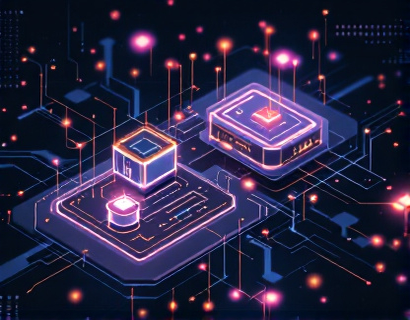Streamlining Digital Currency Creation: A Comprehensive Guide to Next-Gen Software for Businesses and Blockchain Innovators
The advent of blockchain technology has revolutionized the way we think about digital currencies and financial systems. For businesses and blockchain innovators, creating a digital currency can be a complex and daunting task, involving intricate technical processes and a deep understanding of cryptographic principles. However, with the emergence of advanced software solutions, the process of developing, customizing, and managing digital currencies has become significantly more accessible and efficient. This comprehensive guide delves into the key aspects of streamlining digital currency creation, focusing on the next-generation software that empowers users with unparalleled customization, robust security, and seamless scalability.
Understanding the Basics of Digital Currency Creation
Before exploring the software tools available for digital currency creation, it's essential to understand the fundamental components and processes involved. A digital currency, often referred to as a cryptocurrency, operates on a decentralized blockchain network. This network consists of a distributed ledger that records all transactions across a network of computers, ensuring transparency, security, and immutability.
The creation of a digital currency involves several critical steps: defining the currency's properties, developing the blockchain protocol, implementing smart contracts (if applicable), and deploying the currency on the blockchain. Each of these steps requires a solid grasp of cryptography, programming, and blockchain architecture. Traditional methods often involve writing extensive code from scratch, which can be time-consuming and error-prone.
The Role of Advanced Software in Digital Currency Creation
Advanced software solutions have emerged to simplify and streamline the digital currency creation process. These platforms provide a user-friendly interface that abstracts the complex underlying technologies, allowing users to focus on customization and innovation rather than getting bogged down by technical details. The key features of these next-gen software tools include:
- Customization: Users can tailor the digital currency to meet specific business needs, including coin design, transaction fees, and reward mechanisms.
- Security: Robust security measures are built into the platform to protect against common vulnerabilities and ensure the integrity of the blockchain.
- Scalability: The software is designed to handle a growing number of transactions and users without compromising performance.
- Ease of Use: Intuitive interfaces and comprehensive documentation make it accessible for users with varying levels of technical expertise.
Customization Options
One of the most significant advantages of using advanced software for digital currency creation is the level of customization available. Users can define various parameters to suit their unique requirements:
- Coin Design: Customize the appearance and properties of the digital coins, including name, symbol, and visual design.
- Consensus Mechanism: Choose from a variety of consensus algorithms such as Proof of Work (PoW), Proof of Stake (PoS), or Delegated Proof of Stake (DPoS) to determine how new blocks are added to the blockchain.
- Transaction Fees: Set custom transaction fees to incentivize network participants and manage network congestion.
- Reward Mechanisms: Define how and when rewards are distributed to miners or validators, and adjust parameters like block rewards and staking rates.
These customization options allow businesses and innovators to create digital currencies that align with their specific goals and target markets.
Robust Security Features
Security is paramount in the world of digital currencies. Advanced software platforms incorporate multiple layers of security to protect the blockchain and its users:
- Cryptographic Algorithms: Utilize state-of-the-art cryptographic techniques to secure transactions and ensure data integrity.
- Smart Contract Auditing: Provide tools for auditing and testing smart contracts to identify and mitigate potential vulnerabilities.
- Multi-Signature Wallets: Offer multi-signature wallet options to enhance security for storing and managing digital assets.
- Regular Updates and Patches: Ensure the platform is regularly updated to address new threats and vulnerabilities.
By integrating these security features, users can have confidence in the safety and reliability of their digital currency.
Seamless Scalability
As the user base and transaction volume grow, the ability to scale the blockchain is crucial. Advanced software solutions are designed to handle increasing loads without compromising performance:
- Sharding: Implement sharding techniques to divide the blockchain into smaller, more manageable parts, each handling a subset of transactions.
- Layer 2 Solutions: Integrate layer 2 protocols such as state channels and sidechains to offload transactions from the main blockchain, reducing congestion and improving speed.
- Dynamic Adjustments: Allow for dynamic adjustments to block size and difficulty to maintain a consistent block time and network throughput.
These scalability features ensure that the digital currency can grow and adapt to changing demands, maintaining a smooth and efficient user experience.
User-Friendly Interfaces and Comprehensive Documentation
To make digital currency creation accessible to a broader audience, advanced software platforms prioritize user-friendly interfaces and comprehensive documentation:
- Intuitive Dashboards: Provide intuitive dashboards that allow users to easily manage and monitor various aspects of their digital currency, from coin distribution to transaction history.
- Step-by-Step Guides: Offer detailed, step-by-step guides and tutorials to help users navigate the creation and deployment process.
- Community Support: Establish active communities and support forums where users can seek help, share knowledge, and collaborate on projects.
By focusing on usability and support, these platforms lower the barrier to entry for businesses and innovators looking to enter the blockchain space.
Case Studies and Real-World Applications
To better understand the practical applications and benefits of advanced digital currency creation software, let's explore a few real-world examples:
- Decentralized Finance (DeFi) Platforms: Several DeFi projects have utilized advanced software to create custom tokens and smart contracts, enabling complex financial products and services on blockchain networks. These platforms have streamlined the development process, allowing developers to focus on innovation rather than building everything from scratch.
- Enterprise Solutions: Large corporations are leveraging these tools to create private blockchains for supply chain management, identity verification, and other business processes. The customization and security features ensure that these solutions meet enterprise-level requirements.
- Community-Driven Projects: Open-source communities have used these platforms to develop and launch their own digital currencies, fostering decentralization and community engagement. The ease of use and comprehensive documentation have democratized the process, enabling more people to participate in blockchain development.
Future Trends and Innovations
The landscape of digital currency creation is continually evolving, with several emerging trends and innovations on the horizon:
- Interoperability: Efforts to enhance interoperability between different blockchain networks are gaining momentum, allowing digital currencies to seamlessly interact and transfer value across platforms.
- Sustainability: There is a growing focus on developing energy-efficient consensus mechanisms and sustainable blockchain solutions to reduce the environmental impact of digital currencies.
- Regulatory Compliance: As the adoption of digital currencies grows, tools that simplify compliance with regulatory requirements are becoming increasingly important. Advanced software platforms are incorporating features to help users navigate the complex regulatory landscape.
These trends indicate a future where digital currency creation will become even more accessible, efficient, and integrated into mainstream financial systems.
Conclusion
Advanced software solutions have transformed the process of creating and managing digital currencies, making it more accessible, secure, and scalable for businesses and blockchain innovators. By leveraging these tools, users can focus on innovation and value creation, rather than getting entangled in the technical complexities of blockchain development. As the technology continues to evolve, the potential for digital currencies to revolutionize various industries and aspects of our lives becomes increasingly evident.










































